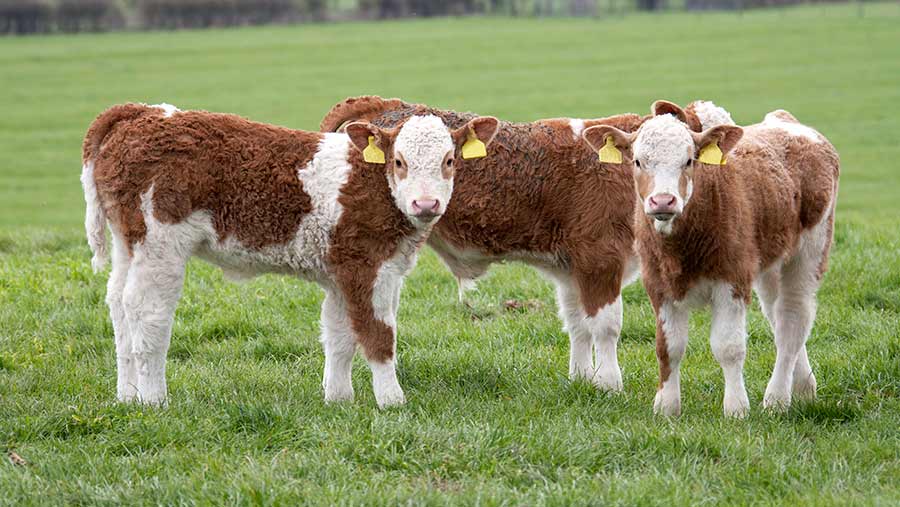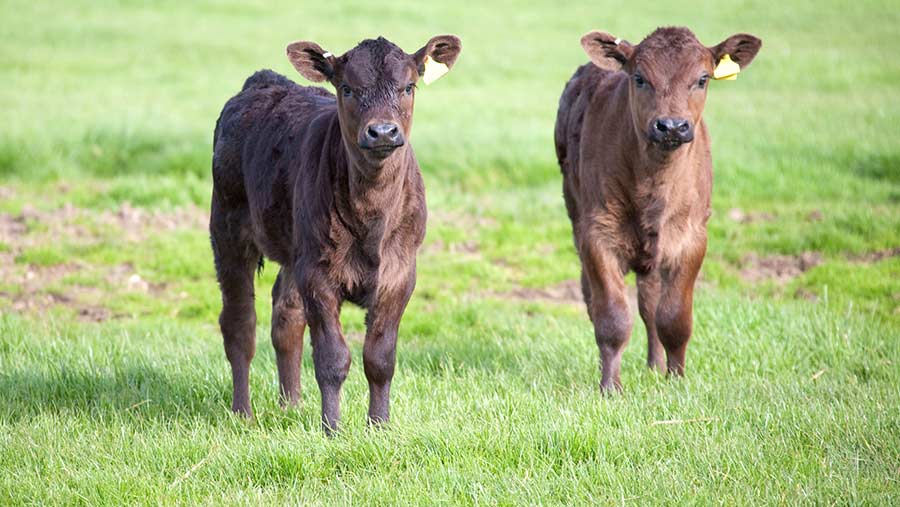Expert advice on creep feeding calves
 © Tim Scrivener
© Tim Scrivener Keeping a tight grip on feed costs is a priority for every beef farmer, but creep feeding suckled calves can be a good return on investment.
Maximising the calf’s efficiency at this early stage is becoming much more important with modern market requirements for younger, lighter carcasses.
The feed conversion efficiency of calves pre-weaning is the highest it will be at any subsequent period – on average every 3.5-4kg of dry matter feed a calf consumes will result in 1kg of daily liveweight gain (dlwg).
Debbie James spoke to independent ruminant nutritionist David Hendy to get his advice on creep feeding.
Benefits of creep feeding
- Calves have a feed conversion efficiency up to three times that of a cow so it is more cost-effective to feed the calf rather than the cow late in her lactation
- Helps maintain growth rates when milk or grass is insufficient late in the season
- Can increase growth rates
- Will help with rumen development
- Acclimatises calf to a change in nutrition at weaning
- Reduces the cow’s nutritional requirements and helps her maintain body condition in late lactation
1. When creep feed should be introduced
Calves as young as three weeks will start to nibble at calf creep feeds but they won’t consume and digest very much of this before they are six to eight weeks old.
However, for bull calves moving into a bull beef system, provide creep from at least eight weeks by separating from the heifers and steers once stock bulls are taken out of bulling groups.
See also: Three stage feeding approach is helping beef farmers hit specifications
Calves can consume up to 4kg/head/day, but be guided by milk and grass availability and quality of pasture on when to introduce.
For calves born in spring or early summer, grass and milk will decrease from early July onwards so introduce creep at least two months before weaning.
For calves born in late summer and autumn, introduce creep at housing, although this can be later for heifers and steers.
If calves are weaned at turnout or later in the spring/summer, creep feeding may not initially be needed at grass because they will utilise fresh pasture at turnout, but Mr Hendy advises reintroducing approximately two months prior to weaning.
This should contain high levels of digestible fibre such as whole oats and/or sugar beet pulp and once calves have got used to this diet gradually introduce cereals and other starch-based feeds.
2. How to feed
Have at least one five-space creep feeder for every 20 calves because too few feeders will result in bullying and under-performance in smaller, younger calves.
By providing sufficient feeders in the field or yards, all calves can feed when they want to.
Move the feeders if the area becomes wet and muddy.
3. What to feed
To get the best results from creep feeding, there must be a nutritional balance, with crude protein at 18%/kg dry matter or higher, and including up to 30% bypass protein.
Once the diet has been established, reduce protein levels to 15-16%kg/DM.
Energy levels should be moderate to high – 11-12 ME/kgDM and digestible fibre at least 30% neutral detergent fibre (NDF).
Where possible, up to 8% long fibre chopped to muzzle width can be fed, but only if this can be fed in troughs or bunkers, or included in a total mixed ration; don’t include if feeding in calf creep feeders or hoppers as it can cause bridging or blockages in the hoppers.
Mr Hendy also advises including a recommended mineral and vitamin at 2.5% inclusion; if there are known trace element or vitamin deficiencies, include further supplementation.
Where possible, include whole oats in calf creep feeds as they are slow to break down and help rumen development.
“You can feed whole oats to calves up to eight or nine months of age, but when they start to be seen in calf dung then they should be rolled,’’ says Mr Hendy.
If oats aren’t available, other high-fibre feeds, such as sugar beet pulp, wheat feed pellets, malt culm or malt residual pellets or soya hulls, can be included.
Water troughs should be clean, with fresh water easily accessible to calves.
4. Different management strategies for feeding creep
Creep feeding isn’t only about providing a concentrate feed – aftermaths and new grass growth can be offered to calves before grazed by cows.
For this system, known as “forward creep feeding’’, erect a simple electric fence with a creep gate to allow calves to pass through.
“To get calves used to the system, the whole herd could be put in to the creep area for a relatively short period, perhaps up to half a day depending on factors such as the size of area,’’ says Mr Hendy.
“Return them to their existing field and then allow the calves through to the creep area via a calf creep gate or pop hole.’’
Equally, a creep feeder can be placed in the “forward grazing” area or, if necessary, calves can be fed daily in troughs, he adds.
“It will help calf growth where grass regrowth is poor, or if the cows are being fed silage late in the season and will help calves acclimatise in a small but significant way to being away from the herd prior to weaning.’’
Creep feeding forage brassicas and stubble turnips is another option or having forage available in an area not accessible by cows so calves can have some long fibre when the herd is on lush pastures in early spring, late summer or autumn.
Specific yarded space or pens for calves from autumn and winter-calving housed herds allow calves to be fed specific creep feeds or a total mixed ration.
5. Example rations
Where a traditional creep feed is used, the ration can be a simple cereal and protein combination, mixed on farm.
It can also include blends, coarse mixes or pelleted feeds, or simple two-way mixes of whole oats and malt culm pellets or whole oats and maize gluten with appropriate minerals added.
“It doesn’t need to be complicated – simple can work just as well,’’ says Mr Hendy.
Liquid feeds, mostly molasses-based, could be used in ball or wheel feeders with protein of varying levels and types. However, Mr Hendy warns against including liquids containing urea before calves are four to five months old.
“Urea can be used in rations from three months onwards where calves are already having a concentrate ration, such as in dairy bred calf rearing systems, but it’s always advisable not to include urea in suckler calves before four to five months if no concentrate ration has been fed.’’
Example rations for creep feeding
Diet 1
- 50kg cane/beet molasses
- 175kg rolled barley
- 175kg rolled wheat
- 200kg whole oats
- 200kg sugar beet pulp
- 100kg HiPro soya/rapeseed blend
- 25kg general-purpose minerals
- 25kg limestone flour
- 1,000kg
- 12ME, 16.2% CP, 20.5% NDF, 30% starch, 10% sugar
Diet 2
- 50kg cane/beet molasses
- 450kg whole oats
- 450kg maize gluten pellets
- 25kg general-purpose minerals
- 25kg limestone flour
- 1,000kg
- 11.7ME, 15% CP, 30% NDF, 31% starch, 5% sugar

